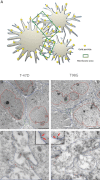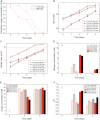Alterations of monocarboxylate transporter densities during hypoxia in brain and breast tumour cells
- PMID: 22700320
- PMCID: PMC3396336
- DOI: 10.1007/s13402-012-0081-9
Alterations of monocarboxylate transporter densities during hypoxia in brain and breast tumour cells
Abstract
Background: Tumour cells are characterized by aerobic glycolysis, which provides biomass for tumour proliferation and leads to extracellular acidification through efflux of lactate via monocarboxylate transporters (MCTs). Deficient and spasm-prone tumour vasculature causes variable hypoxia, which favours tumour cell survival and metastases. Brain metastases frequently occur in patients with advanced breast cancer.Effective treatment strategies are therefore needed against brain metastasis from breast carcinoma.
Material and methods: In order to identify differences in the capacity for lactate exchange, human T-47D breast cancer cells and human glioblastoma T98G cells were grown under 4 % or 20 % oxygen conditions and examined for MCT1, MCT2 and MCT4 expression on plasma membranes by quantitative post embedding immunogold electron microscopy. Whereas previous studies on MCT expression in tumours have recorded mRNA and protein levels in cell extracts, we examined concentrations of the proteins in the microvillous plasma membrane protrusions specialized for transmembrane transport.
Results: In normoxia, both tumour cell types highly expressed the low affinity transporter MCT4, which is thought to mainly mediate monocarboxylate efflux, while for high affinity transport the breast tumour cells preferentially expressed MCT1 and the brain tumour cells resembled brain neurons in expressing MCT2, rather than MCT1. The expressions of MCT1 and MCT4 were upregulated in hypoxic conditions in both breast and brain tumour cells. The expression of MCT2 also increased in hypoxic breast cancer cells, but decreased in hypoxic brain tumour cells. Quantitative immunoblots showed similar hypoxia induced changes in the protein levels.
Conclusion: The differential expression and regulation of MCTs in the surface membranes of hypoxic and normoxic tumour cells of different types provide a foundation for innovation in tumour therapy through the selective targeting of MCTs. Selective inhibition of various MCTs could be an efficient way to quench an important energy source in both original breast tumour and metastatic cancer tissue in the brain.
Figures





Similar articles
-
Targeting lactate transport suppresses in vivo breast tumour growth.Oncotarget. 2015 Aug 7;6(22):19177-89. doi: 10.18632/oncotarget.3910. Oncotarget. 2015. PMID: 26203664 Free PMC article.
-
Exercise-induced changes in tumour LDH-B and MCT1 expression are modulated by oestrogen-related receptor alpha in breast cancer-bearing BALB/c mice.J Physiol. 2015 Jun 15;593(12):2635-48. doi: 10.1113/JP270463. Epub 2015 May 18. J Physiol. 2015. PMID: 25907793 Free PMC article.
-
Hypoxia stimulates lactate release and modulates monocarboxylate transporter (MCT1, MCT2, and MCT4) expression in human adipocytes.Pflugers Arch. 2010 Feb;459(3):509-18. doi: 10.1007/s00424-009-0750-3. Epub 2009 Oct 30. Pflugers Arch. 2010. PMID: 19876643
-
Immunogold cytochemistry identifies specialized membrane domains for monocarboxylate transport in the central nervous system.Neurochem Res. 2002 Feb;27(1-2):89-96. doi: 10.1023/a:1014806723147. Neurochem Res. 2002. PMID: 11926280 Review.
-
Targeting monocarboxylate transporters (MCTs) in cancer: How close are we to the clinics?Semin Cancer Biol. 2023 May;90:1-14. doi: 10.1016/j.semcancer.2023.01.007. Epub 2023 Jan 24. Semin Cancer Biol. 2023. PMID: 36706846 Review.
Cited by
-
Beta-hydroxybutyrate (3-OHB) can influence the energetic phenotype of breast cancer cells, but does not impact their proliferation and the response to chemotherapy or radiation.Cancer Metab. 2018 Jun 11;6:8. doi: 10.1186/s40170-018-0180-9. eCollection 2018. Cancer Metab. 2018. PMID: 29942509 Free PMC article.
-
pH, Lactate, and Hypoxia: Reciprocity in Regulating High-Affinity Monocarboxylate Transporter Expression in Glioblastoma.Neoplasia. 2017 Feb;19(2):121-134. doi: 10.1016/j.neo.2016.12.011. Epub 2017 Jan 13. Neoplasia. 2017. PMID: 28092823 Free PMC article.
-
Functional activation of pyruvate dehydrogenase in human brain using hyperpolarized [1-13 C]pyruvate.Magn Reson Med. 2024 May;91(5):1822-1833. doi: 10.1002/mrm.30015. Epub 2024 Jan 24. Magn Reson Med. 2024. PMID: 38265104 Free PMC article.
-
Monocarboxylate transporters in cancer.Mol Metab. 2020 Mar;33:48-66. doi: 10.1016/j.molmet.2019.07.006. Epub 2019 Jul 27. Mol Metab. 2020. PMID: 31395464 Free PMC article. Review.
-
FABP7 is a key metabolic regulator in HER2+ breast cancer brain metastasis.Oncogene. 2019 Sep;38(37):6445-6460. doi: 10.1038/s41388-019-0893-4. Epub 2019 Jul 19. Oncogene. 2019. PMID: 31324889 Free PMC article.
References
-
- Warburg O. On respiratory impairment in cancer cells. Science. 1956;124:269–270. - PubMed
-
- Vander Heiden MG, Locasale JW, Swanson KD, Sharfi H, Heffron GJ, Amador-Noguez D, Christofk HR, Wagner G, Rabinowitz JD, Asara JM, Cantley LC. Evidence for an alternative glycolytic pathway in rapidly proliferating cells. Science. 2010;329:1492–1499. doi: 10.1126/science.1188015. - DOI - PMC - PubMed
Publication types
MeSH terms
Substances
LinkOut - more resources
Full Text Sources
Medical

